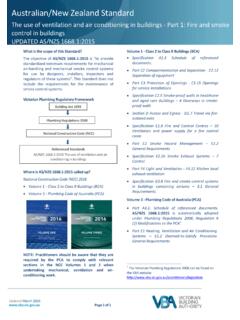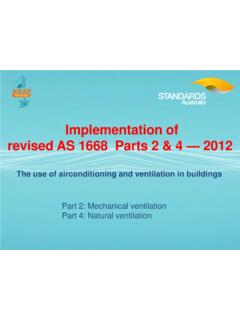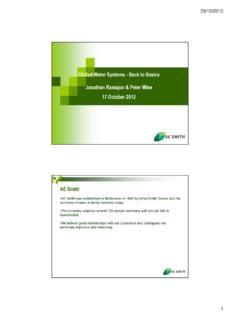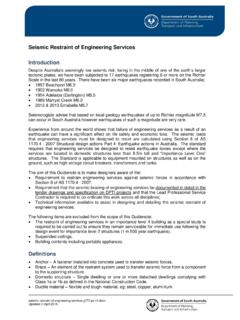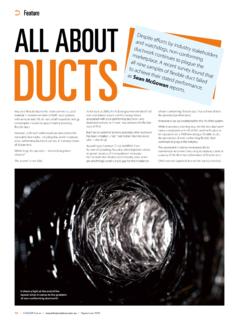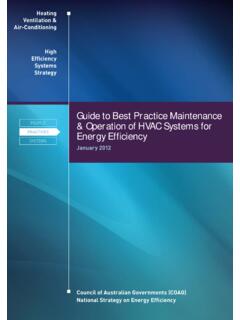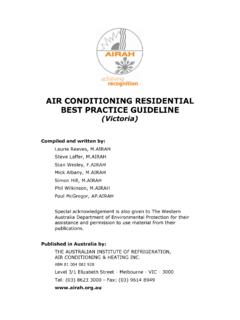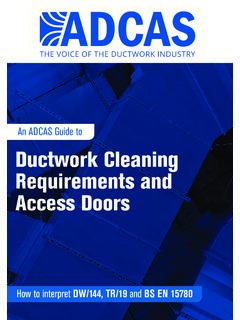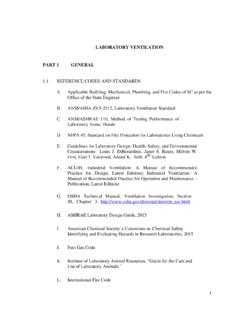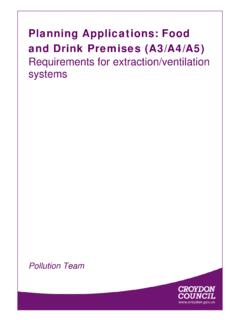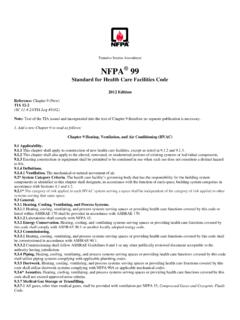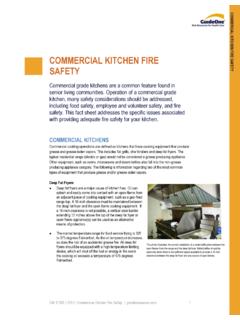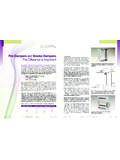Transcription of Fire safety - AIRAH
1 THE AUSTRALIAN INSTITUTE OF. TECHNICAL BULLETIN. REFRIGERATION, AIR CONDITIONING AND HEATING. fire safety . Kitchen hood exhaust systems Understanding and addressing the special fire risks inherent in commercial kitchen ventilation systems TECHNICAL BULLETIN 2016. fire safety Kitchen hood exhaust systems TECHNICAL BULLETIN. fire safety . Kitchen hood exhaust systems Understanding and addressing the special fire risks inherent in commercial kitchen ventilation systems Preface It aims to highlight the main fire safety issues, promote a common language, and improve Kitchen exhaust systems continue to feature understanding of the risks and resulting prominently in commercial building fire events. responsibilities of all participants in the supply chain, from design and installation through fire safety within kitchen ventilation systems in to operation and ongoing maintenance.
2 Not just a matter for the system designer or system installer. The actions of the facilities manager, the Kitchen ventilation systems and their impact on maintenance contractor, and the system owner or fire safety can be improved within the community. operator are also critical to ensuring safe outcomes. Systems need to be designed and installed in accordance with the established rules. In the light of recent updates to relevant Ongoing maintenance and inspection should Australian Standards, recent changes to the be targeted to the actual usage of the facility maintenance requirements and focus of the and its delivery should be verified. AIRAH hopes National Construction Code, and the continuing that this fire safety technical bulletin will go some fire risks within kitchens, AIRAH undertook to way to improving industry performance in this area develop a fire safety technical bulletin on the exhaust and reducing the incidence of serious fires within ventilation topic, in partnership with the industry.
3 Kitchen exhaust systems. This technical bulletin has been developed for Vincent Aherne, use by technical service providers, facilities AIRAH technical manager managers, and operators of commercial kitchens. Disclaimer The information or advice contained in this document is intended for use only by those who have adequate technical training in the field to which this technical bulletin relates. The document has been compiled as an aid, only and the information or advice should be verified before it is put to use. Reasonable efforts have been taken to ensure that the information or advice is accurate, reliable and accords with current standards as at the date of publication. To the maximum extent permitted by law, the Australian Institute of Refrigeration Air Conditioning and Heating Inc.
4 , its officers, employees and agents a) disclaim all responsibility and all liability (including without limitation, liability in negligence) for all expenses, losses, damages and costs, whether direct, indirect, consequential or special you might incur as a result of the information in this publication being inaccurate or incomplete in any way, and for any reason; and b) exclude any warranty, condition, guarantee, description or representation in relation to this publication, whether express or implied. In all cases, the user should also establish the accuracy, currency and applicability of the information or advice in relation to any specific circumstances and must rely on his or her professional judgement at all times.
5 AIRAH 2016. 1. TECHNICAL BULLETIN fire safety Kitchen hood exhaust systems Contributors This Technical Bulletin was prepared by AIRAH in collaboration with a range of AIRAH members, industry organisations and individuals. The following organisations and individuals are acknowledged for their contribution to its development: n AIRAH Vince Aherne, , n Peter Mathieson, Phil Wilkinson, n Vanessa Morris ACT Government n FPAA B. rett Dundules; Ian Findlay;. Chris Orr, Brett Staines; Matthew Wright n Jessica Ngo CFA. n Greg Buckley fire NSW/AFAC n Kevin O'Reilly, n Peter Conroy City of Sydney n Ivano Piubellini n Dan Dainard, n Bryon Price, n Brett Fairweather, n David Robinson, n James Fricker, n Jeremy Stamkos n Simon Hill, n Grant Mogford n David Kearsley CFA n Ross Warner, n Doug Lamac n Graeme Williamson About AIRAH .
6 The Australian Institute of Refrigeration, Air Conditioning and Heating ( AIRAH ) is an independent, specialist, not-for-profit technical organisation providing leadership in the HVAC&R sector through collaboration, engagement and professional development. The Institute's mission is to lead, promote, represent and support the HVAC and related services industry, and membership. The Institute produces a variety of publications, communications and training programs aimed at championing the highest of industry standards. AIRAH encourages world's best practice within the industry, and has forged a reputation for developing the competency and skills of industry practitioners at all levels. 2. fire safety Kitchen hood exhaust systems TECHNICAL BULLETIN.
7 Contents 1. Kitchen exhaust is there a safety problem? 4. 2. Kitchen exhaust what are the fire hazards? 4. 3. Identifying the fire risks 6. 4. Addressing the fire risks 7. 5. Seven deadly sins 9. 6. Ongoing inspection and maintenance 13. 7. Beyond the minimum standards Towards best practice 15. 8. Going the extra mile 16. 9. What can I do? 17. 10. Further information 18. 3. TECHNICAL BULLETIN fire safety Kitchen hood exhaust systems 1. Kitchen exhaust 2. Kitchen exhaust is there a what are the safety problem? fire hazards? There continues to be fire incidents involving the Fires are common in restaurants and typically start in mechanical exhaust ventilation systems of commercial the kitchen area. Cooking materials are the most frequent kitchens.
8 Given the presence of heat and high fuel loads, first item' ignited. Experience shows that the majority fires in kitchens are not uncommon. However, when the of kitchen fires will involve the kitchen exhaust hood incident extends into the mechanical exhaust system, or ductwork. safety risks and building impacts can rapidly escalate, sometimes resulting in devastating and widespread Kitchen exhaust fires can spread in a number of ways. damage. These high-intensity fires move and spread A fire that originates within the kitchen or at the hood rapidly, are difficult to locate and extinguish, and are filters can spread into and up the ductwork system, fuelled susceptible to remote re-ignition and break-out. by the oil and grease within the duct.
9 A fire within the duct can ignite combustible materials outside of the duct, This technical bulletin is provided to help raise awareness via radiant heat transmission, or can ignite grease that has among property owners and restaurant proprietors leaked out of duct seams, spreading the fire in the building. about the fire risks and dangers associated with kitchen Because fire dampers are not allowed within kitchen exhaust ventilation systems. It discusses the inherent fire exhaust ductwork, fire spread within and between ducts risks, outlines regulatory and compliance requirements, can compromise a building's passive fire protection such highlights recent changes to applicable Australian as fire -rated compartments.
10 Standards, looks at best-practice approaches, and emphasises the importance of ongoing effective cleaning and maintenance. fire dampers, which are usually installed in ventilation ducts to prevent fire spread, are not permitted within a kitchen exhaust duct system. fire FACTS They do not work in kitchen exhaust because grease on the downstream side of the damper Duct fires can be intense and reach temperatures will ignite before, and irrespective of, damper closure. of 1,000 C within minutes hot enough to melt The potential for false operation of the fire damper some metals and ignite surrounding combustibles. is also greater than normal and closure, other than fire statistics from Australia, the UK and the US in a fire situation, can have serious consequences show that fires in restaurants predominately occur for kitchen ventilation.
